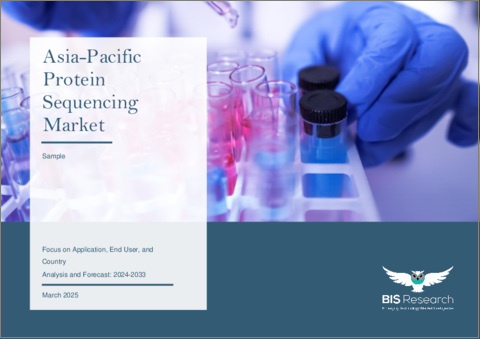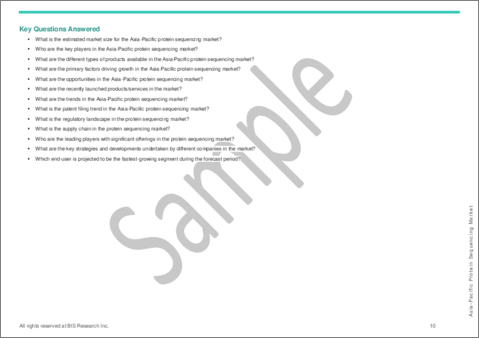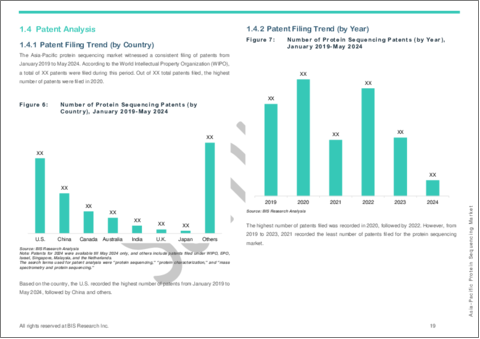|
|
市場調査レポート
商品コード
1681512
アジア太平洋のタンパク質シーケンシング市場:用途・エンドユーザー・国別の分析・予測 (2024-2033年)Asia-Pacific Protein Sequencing Market: Focus on Application, End User, and Country - Analysis and Forecast, 2024-2033 |
||||||
カスタマイズ可能
|
|||||||
| アジア太平洋のタンパク質シーケンシング市場:用途・エンドユーザー・国別の分析・予測 (2024-2033年) |
|
出版日: 2025年03月19日
発行: BIS Research
ページ情報: 英文 57 Pages
納期: 1~5営業日
|
全表示
- 概要
- 図表
- 目次
アジア太平洋地域のタンパク質シーケンシングの市場規模は、2024年の3億7,130万米ドルから、予測期間中は5.93%のCAGRで推移し、2033年には6億2,350万米ドルに達すると予測されています。
アジア太平洋地域では、プロテオミクス研究への投資の増加、バイオ医薬品産業の拡大、個別化医療への需要の高まりを背景に、タンパク質シーケンシングの採用が加速しています。主なシーケンシング技術としては、より小さなタンパク質に適したエドマン分解と、高いスループットと複雑なサンプルの解析能力により大規模プロテオミクスに広く利用されている質量分析の2つがあります。市場には、シーケンシングプロセスを可能にする機器、試薬、消耗品に加え、専門的なシーケンシングサービスを提供するCROも含まれます。
| 主要市場統計 | |
|---|---|
| 予測期間 | 2024-2033年 |
| 2024年評価 | 3億7,130万米ドル |
| 2033年予測 | 6億2,350万米ドル |
| CAGR | 5.93% |
バイオマーカー探索、医薬品開発、疾病診断に対する需要の高まりが、タンパク質シーケンシング技術の絶え間ない革新を促進しています。アジア太平洋地域の政府と民間部門がライフサイエンスに多額の投資を行っているため、この地域はプロテオミクスとタンパク質ベースの研究で大きな進歩を遂げる態勢が整っています。
アジア太平洋地域のタンパク質シーケンシング市場は、ライフサイエンスへの投資の増加、バイオテクノロジー分野の拡大、精密医療に対する需要の高まりに牽引され、急速な成長を遂げています。中国、日本、インド、韓国のような国々がプロテオミクス研究への注力を強化する中、創薬、疾病診断、バイオマーカー同定においてタンパク質シーケンシングが牽引役となっています。
高分解能質量分析計や自動エドマン分解などのシーケンシング技術の進歩により、タンパク質解析の精度と効率が向上しています。さらに、研究機関、製薬会社、医薬品開発業務受託機関 (CRO) の連携がイノベーションを促進し、市場拡大を加速しています。
慢性疾患の有病率の増加と標的治療の必要性が、生物医学研究におけるタンパク質シーケンシングの採用をさらに後押ししています。政府の強力な支援、研究開発資金の増加、技術の進歩により、アジア太平洋のタンパク質シーケンシング市場は大きく拡大し、同地域の個別化医療とバイオ医薬品開発の未来を形作ることになるでしょう。
市場の分類
セグメンテーション1:用途別
- バイオセラピューティクス
- 遺伝子工学
- その他
セグメンテーション2:エンドユーザー別
- 学術機関
- 製薬会社およびCRO
- バイオテクノロジー、診断薬、その他の企業
セグメンテーション3:地域別
- アジア太平洋
- 中国
- 日本
- インド
- オーストラリア
- 韓国
- その他
当レポートでは、アジア太平洋地域のタンパク質シーケンシングの市場を調査し、主要動向、市場影響因子の分析、法規制環境、技術開発・特許の動向、市場規模の推移・予測、各種区分・主要国別の詳細分析、競合情勢、主要企業のプロファイルなどをまとめています。
目次
エグゼクティブサマリー
第1章 アジア太平洋のタンパク質シーケンシング市場:概要
- 動向:現在および将来の影響評価
- 市場における製品投入の増加
- 単分子タンパク質シーケンシングの採用拡大
- 生物製剤開発への高い需要
- タンパク質シーケンシングのワークフロー
- タンパク質シーケンシングワークフローの概要
- 規制の枠組み
- 日本
- 中国
- 特許分析
- 特許出願動向 (国別)
- 特許出願動向 (年別)
- 市場力学の概要
- 市場促進要因
- 市場抑制要因
- 市場機会
第2章 アジア太平洋のタンパク質シーケンシング市場 (国別)
- 地域サマリー
- アジア太平洋
- 地域概要
- 市場成長推進因子
- 市場課題
- 中国
- 日本
- インド
- オーストラリア
- 韓国
- その他
第3章 市場:競合情勢
- タンパク質シーケンシング市場:競合情勢
- 企業戦略:2021年1月~2024年9月
- 事業戦略:2021年1月~2024年9月
- サービス/製品の発売
- 企業プロファイル
- FUJIFILM Holdings Corporation
- Shimadzu Corporation
第4章 調査手法
List of Figures
- Figure 1: Asia-Pacific Protein Sequencing Market, $Million, 2024, 2028, and 2033
- Figure 2: Asia-Pacific Protein Sequencing Market (by Application), $Million, 2023, 2027, and 2033
- Figure 3: Asia-Pacific Protein Sequencing Market (by End User), $Million, 2023, 2027, and 2033
- Figure 4: Key Events to Keep Track of in the Protein Sequencing Market
- Figure 5: Protein Sequencing Workflow Overview
- Figure 6: Number of Protein Sequencing Patents (by Country), January 2019-May 2024
- Figure 7: Number of Protein Sequencing Patents (by Year), January 2019-May 2024
- Figure 8: Impact Analysis of Market Navigating Factors, 2022-2033
- Figure 9: China Protein Sequencing Market, $Million, 2022-2033
- Figure 10: Japan Protein Sequencing Market, $Million, 2022-2033
- Figure 11: India Protein Sequencing Market, $Million, 2022-2033
- Figure 12: Australia Protein Sequencing Market, 2022-2033
- Figure 13: South Korea Protein Sequencing Market, $Million, 2022-2033
- Figure 14: Rest-of-Asia-Pacific Protein Sequencing Market, $Million, 2022-2033
- Figure 15: Corporate Strategies, January 2021- September 2024
- Figure 16: Product Launches (by Company), January 2021-September 2024
- Figure 17: Data Triangulation
- Figure 18: Top-Down and Bottom-Up Approach
- Figure 19: Assumptions and Limitations
List of Tables
- Table 1: Market Snapshot
- Table 2: Protein Sequencing Market Opportunities
- Table 3: Product Launches, January 2023-September 2024
- Table 4: Companies Providing Single-Molecule Protein Sequencing
- Table 5: List of Molecular Targets Identified with Proteomics
- Table 6: Major Protein Sequencing and Mass Spectrometry Service Fee
- Table 7: Asia-Pacific Protein Sequencing Market (by End User), $Million, 2022-2033
- Table 8: Asia-Pacific Protein Sequencing Market (by Application), $Million, 2022-2033
Introduction to Asia-Pacific Protein Sequencing Market
The Asia-Pacific protein sequencing market is projected to reach $623.5 million by 2033 from $371.3 million in 2024, growing at a CAGR of 5.93% during the forecast period 2024-2033. Protein sequencing is the process of identifying the precise order of amino acids in a protein, essential for understanding its structure, function, and role in biological systems. It is crucial in biotechnology, biomedical research, drug discovery, and disease diagnostics, playing a key role in advancing precision medicine and targeted therapies. Protein sequencing provides critical insights into post-translational modifications, protein interactions, and disease mechanisms, supporting breakthroughs in life sciences and healthcare.
In the APAC region, the adoption of protein sequencing is accelerating, driven by increasing investments in proteomics research, expanding biopharmaceutical industries, and rising demand for personalized medicine. The two primary sequencing techniques are Edman degradation, suitable for smaller proteins, and mass spectrometry, widely used for large-scale proteomics due to its high throughput and ability to analyze complex samples. The market includes instruments, reagents, and consumables that enable sequencing processes, along with contract research organizations offering specialized sequencing services.
| KEY MARKET STATISTICS | |
|---|---|
| Forecast Period | 2024 - 2033 |
| 2024 Evaluation | $371.3 Million |
| 2033 Forecast | $623.5 Million |
| CAGR | 5.93% |
Growing demand for biomarker discovery, drug development, and disease diagnostics is fostering continuous innovation in protein sequencing technologies. As governments and private sectors in APAC invest heavily in life sciences, the region is poised for significant advancements in proteomics and protein-based research.
Market Introduction
The APAC protein sequencing market is experiencing rapid growth, driven by increasing investments in life sciences, expanding biotechnology sectors, and the rising demand for precision medicine. As countries like China, Japan, India, and South Korea strengthen their focus on proteomics research, protein sequencing is gaining traction in drug discovery, disease diagnostics, and biomarker identification.
Advancements in sequencing technologies, such as high-resolution mass spectrometry and automated Edman degradation, are enhancing the accuracy and efficiency of protein analysis. Additionally, collaborations between research institutions, pharmaceutical companies, and contract research organizations (CROs) are fostering innovation and accelerating market expansion.
The growing prevalence of chronic diseases and the need for targeted therapies further drive the adoption of protein sequencing in biomedical research. With strong government support, increased R&D funding, and technological advancements, the APAC protein sequencing market is set for significant expansion, shaping the future of personalized medicine and biopharmaceutical development in the region.
Market Segmentation:
Segmentation 1: By Application
- Biotherapeutics
- Genetic Engineering
- Others
Segmentation 2: By End User
- Academic Institutes
- Pharma and CROs
- Biotech, Diagnostics, and Other Companies
Segmentation 3: By Region
- Asia-Pacific
- China
- Japan
- India
- Australia
- South Korea
- Rest-of-Asia-Pacific
How can this report add value to an organization?
Product/Innovation Strategy: The report offers in-depth insights into the latest technological advancements and emerging applications in protein sequencing, enabling organizations to drive innovation and develop cutting-edge products tailored to market needs.
Growth/Marketing Strategy: By providing comprehensive market analysis and identifying key growth opportunities, the report equips organizations with the knowledge to craft targeted marketing strategies and expand their market presence effectively.
Competitive Strategy: The report includes a thorough competitive landscape analysis, helping organizations understand their competitors' strengths and weaknesses and allowing them to strategize effectively to gain a competitive edge in the market.
Key Market Players and Competition Synopsis
Profiled companies have been selected based on inputs gathered from primary experts, as well as analyzing company coverage, product portfolio, and market penetration.
Some prominent names established in this market are:
- Shimadzu Corporation
- FUJIFILM Holdings Corporation
Table of Contents
Executive Summary
Scope and Definition
1 Asia-Pacific Protein Sequencing Market: Overview
- 1.1 Trends: Current and Future Impact Assessment
- 1.1.1 Increasing Product Launches in the Market
- 1.1.2 Growing Adoption of Single-Molecule Protein Sequencing
- 1.1.3 High Demand for Biologics Development
- 1.2 Workflow of Protein Sequencing
- 1.2.1 Protein Sequencing Workflow Overview
- 1.3 Regulatory Framework
- 1.3.1 Japan
- 1.3.1.1 Regulatory Requirements for Protein Sequencing Products Intended as Medical Devices
- 1.3.1.2 Regulatory Requirements for Clinical Protein Sequencing Labs in Japan
- 1.3.2 China
- 1.3.2.1 Regulatory Requirements for Protein Sequencing Products Intended as Medical Devices
- 1.3.1 Japan
- 1.4 Patent Analysis
- 1.4.1 Patent Filing Trend (by Country)
- 1.4.2 Patent Filing Trend (by Year)
- 1.5 Market Dynamics Overview
- 1.5.1 Market Drivers
- 1.5.1.1 Advancements in Computational Biology and Bioinformatics in the Protein Engineering Market
- 1.5.1.2 Expanding Applications in Research
- 1.5.1.3 Technological Advancements in Protein Sequencing
- 1.5.2 Market Restraints
- 1.5.2.1 Shortage of Skilled Labour
- 1.5.2.2 High Cost Hindering the Adoption of Protein Sequencing
- 1.5.3 Market Opportunities
- 1.5.3.1 Integration of Artificial Intelligence in Protein Sequencing
- 1.5.1 Market Drivers
2 Asia-Pacific Protein Sequencing Market (by Country), $Million, 2022-2033
- 2.1 Regional Summary
- 2.2 Asia-Pacific
- 2.2.1 Regional Overview
- 2.2.2 Driving Factors for Market Growth
- 2.2.3 Factors Challenging the Market
- 2.2.4 China
- 2.2.5 Japan
- 2.2.6 India
- 2.2.7 Australia
- 2.2.8 South Korea
- 2.2.9 Rest-of-Asia-Pacific
3 Markets - Competitive Landscape
- 3.1 Protein Sequencing Market: Competitive Landscape
- 3.1.1 Corporate Strategies, January 2021-September 2024
- 3.2 Business Strategies, January 2021-September 2024
- 3.2.1 Service/Product Launches
- 3.3 Company Profiles
- 3.3.1 FUJIFILM Holdings Corporation
- 3.3.1.1 Overview
- 3.3.1.2 Top Products
- 3.3.1.3 Top Competitors
- 3.3.1.4 Target Customers/End Users
- 3.3.1.5 Analyst View
- 3.3.2 Shimadzu Corporation
- 3.3.2.1 Overview
- 3.3.2.2 Top Products
- 3.3.2.3 Top Competitors
- 3.3.2.4 Target Customers/End Users
- 3.3.2.5 Analyst View
- 3.3.1 FUJIFILM Holdings Corporation
4 Research Methodology
- 4.1 Data Sources
- 4.1.1 Primary Data Sources
- 4.1.2 Secondary Data Sources
- 4.1.3 Data Triangulation
- 4.2 Market Estimation and Forecast





